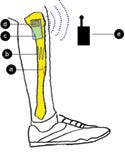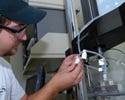January 1, 2007
R&D DIGEST
|
Purdue researcher Ozan Akkus (kneeling) demonstrates the placement of the monitoring device on a student. |
A method that measures earthquakes is being used to create a device that could help prevent stress fractures. Researchers at Purdue University (West Lafayette, IN) are developing a portable prototype that detects tiny cracks in bone and then alerts the user when strenuous physical activity should be stopped.
When an earthquake causes small cracks in structures such as bridges or vessels, the cracks release inaudible sound waves. These waves, called acoustic emissions, can be monitored with special ultrasound sensors. Likewise, when a crack forms in bone, a wave similar to the type created by an earthquake is generated, but at a higher frequency and on a microscopic level. Purdue's prototype, which also has sensors, records the sound wave created by the crack. It could become a key element in avoiding stress fractures.
|
After a microcrack forms (a), a natural sound wave is set off (b). The piezopolymer attached to the skin (c) senses that wave and the integrated microchip (d) emits a signal. A receiver (e) collects the signal and issues an alarm. |
“There is some history of crack initiation and accumulation before the full-blown fracture,” says Ozan Akkus, PhD, associate professor at the Weldon School of Biomedical Engineering at Purdue. “We thought we could get these sensors smaller and more convenient [so that they could] be placed on the skin.” Akkus says the sensors are made from piezopolymer material, which creates electricity when compressed by force. The device also has a wireless transmitter that sends data to a receiver, which analyzes the data and decides whether the signal received from the sensor is indicative of significant cracking or a potential fracture. If it is, an alarm warns the user, and a doctor can then examine the patient.
Akkus worked with researchers at the University of Toledo (Ohio) to make the prototype. The researchers have loaded pieces of human cadaver bone into a materials test machine that bends the bone until it cracks. However, they have yet to identify the frequency content of the signals in real-life situations. To further optimize the technology, Akkus says, they must record the live signals on a population that is likely to experience stress fractures. This includes track runners or even thoroughbred horses.
|
A student at Purdue University studies the bone crack formation resulting from the materials test machine. As the apparatus bends cadaver bone, sensors record the acoustic emissions. |
“After we record these things in real time,” Akkus says, “we need to look at the content of that data, and modify our prototype further so that it's optimized for physiological conditions.” From there, the team can reduce the device's size to that of a personal digital system, and then down to the dimensions of a wristwatch. Akkus envisions that the finished sensors will be the size of Band-Aids. The final device could easily clip onto the body.
The researchers need to determine how far the signals can travel within the body. “For subcutaneous bones like the tibia and the metatarsals, they're immediately under the skin, so there won't be any attenuation problems,” Akkus says. “Once we start getting into bones like the femur, weaker signals may not be able to make it out.”
Another major challenge will be to identify which signals are the most useful in predicting fractures. The research team is now using pattern recognition software and earthquake models to help identify the difference in the types of cracks. Another step forward is to use the device to determine when an athlete has experienced enough damage that exercise should be stopped. This is an important factor in ensuring that an athlete isn't given a premature warning, according to Akkus.
The researchers at Purdue who are working on the project come from a range of disciplines including biomedical and electrical engineering, earth and atmospheric science, and veterinary medicine. The U.S. Army Medical Research and Materiel Command is providing funding.
Copyright ©2007 Medical Device & Diagnostic Industry
About the Author(s)
You May Also Like





